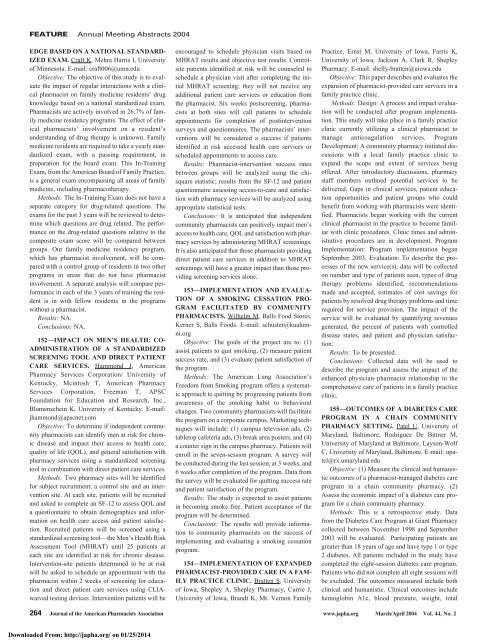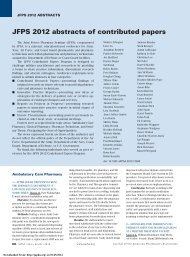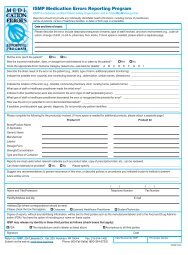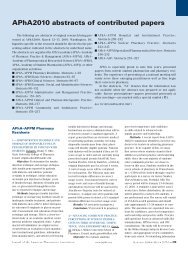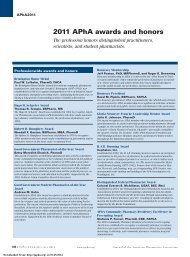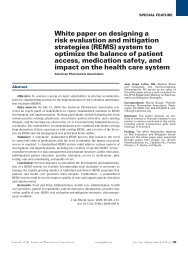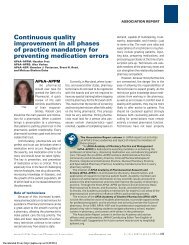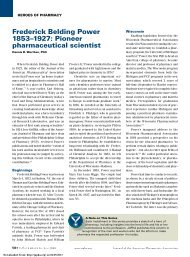Downloaded - Journal of American Pharmacists Association
Downloaded - Journal of American Pharmacists Association
Downloaded - Journal of American Pharmacists Association
You also want an ePaper? Increase the reach of your titles
YUMPU automatically turns print PDFs into web optimized ePapers that Google loves.
FEATURE Annual Meeting Abstracts 2004<br />
EDGE BASED ON A NATIONAL STANDARD-<br />
IZED EXAM. Craft K, Mehra Harris I, University<br />
<strong>of</strong> Minnesota. E-mail: craft006@umn.edu<br />
Objective: The objective <strong>of</strong> this study is to evaluate<br />
the impact <strong>of</strong> regular interactions with a clinical<br />
pharmacist on family medicine residents’ drug<br />
knowledge based on a national standardized exam.<br />
<strong>Pharmacists</strong> are actively involved in 26.7% <strong>of</strong> family<br />
medicine residency programs. The effect <strong>of</strong> clinical<br />
pharmacists’ involvement on a resident’s<br />
understanding <strong>of</strong> drug therapy is unknown. Family<br />
medicine residents are required to take a yearly standardized<br />
exam, with a passing requirement, in<br />
preparation for the board exam. This In-Training<br />
Exam, from the <strong>American</strong> Board <strong>of</strong> Family Practice,<br />
is a general exam encompassing all areas <strong>of</strong> family<br />
medicine, including pharmacotherapy.<br />
Methods: The In-Training Exam does not have a<br />
separate category for drug-related questions. The<br />
exams for the past 3 years will be reviewed to determine<br />
which questions are drug related. The performance<br />
on the drug-related questions relative to the<br />
composite exam score will be compared between<br />
groups. Our family medicine residency program,<br />
which has pharmacist involvement, will be compared<br />
with a control group <strong>of</strong> residents in two other<br />
programs in areas that do not have pharmacist<br />
involvement. A separate analysis will compare performance<br />
in each <strong>of</strong> the 3 years <strong>of</strong> training the resident<br />
is in with fellow residents in the programs<br />
without a pharmacist.<br />
Results: NA.<br />
Conclusions: NA.<br />
152—IMPACT ON MEN’S HEALTH: CO-<br />
ADMINISTRATION OF A STANDARDIZED<br />
SCREENING TOOL AND DIRECT PATIENT<br />
CARE SERVICES. Hammond J, <strong>American</strong><br />
Pharmacy Services Corporation/ University <strong>of</strong><br />
Kentucky, Mcintosh T, <strong>American</strong> Pharmacy<br />
Services Corporation, Freeman T, APSC<br />
Foundation for Education and Research, Inc.,<br />
Blumenschein K, University <strong>of</strong> Kentucky. E-mail:<br />
jhammond@apscnet.com<br />
Objective: To determine if independent community<br />
pharmacists can identify men at risk for chronic<br />
disease and impact their access to health care,<br />
quality <strong>of</strong> life (QOL), and general satisfaction with<br />
pharmacy services using a standardized screening<br />
tool in combination with direct patient care services.<br />
Methods: Two pharmacy sites will be identified<br />
for subject recruitment; a control site and an intervention<br />
site. At each site, patients will be recruited<br />
and asked to complete an SF-12 to assess QOL and<br />
a questionnaire to obtain demographics and information<br />
on health care access and patient satisfaction.<br />
Recruited patients will be screened using a<br />
standardized screening tool—the Men’s Health Risk<br />
Assessment Tool (MHRAT) until 25 patients at<br />
each site are identified at risk for chronic disease.<br />
Intervention-site patients determined to be at risk<br />
will be asked to schedule an appointment with the<br />
pharmacist within 2 weeks <strong>of</strong> screening for education<br />
and direct patient care services using CLIAwaived<br />
testing devices. Intervention patients will be<br />
encouraged to schedule physician visits based on<br />
MHRAT results and objective test results. Controlsite<br />
patients identified at risk will be counseled to<br />
schedule a physician visit after completing the initial<br />
MHRAT screening; they will not receive any<br />
additional patient care services or education from<br />
the pharmacist. Six weeks postscreening, pharmacists<br />
at both sites will call patients to schedule<br />
appointments for completion <strong>of</strong> postintervention<br />
surveys and questionnaires. The pharmacists’ interventions<br />
will be considered a success if patients<br />
identified at risk accessed health care services or<br />
scheduled appointments to access care.<br />
Results: Pharmacist-intervention success rates<br />
between groups will be analyzed using the chisquare<br />
statistic; results from the SF-12 and patient<br />
questionnaire assessing access-to-care and satisfaction<br />
with pharmacy services will be analyzed using<br />
appropriate statistical tests.<br />
Conclusions: It is anticipated that independent<br />
community pharmacists can positively impact men’s<br />
access to health care, QOL and satisfaction with pharmacy<br />
services by administering MHRAT screenings.<br />
It is also anticipated that those pharmacists providing<br />
direct patient care services in addition to MHRAT<br />
screenings will have a greater impact than those providing<br />
screening services alone.<br />
153—IMPLEMENTATION AND EVALUA-<br />
TION OF A SMOKING CESSATION PRO-<br />
GRAM FACILITATED BY COMMUNITY<br />
PHARMACISTS. Wilhelm M, Balls Food Stores,<br />
Kerner S, Balls Foods. E-mail: schuster@kualumni.org<br />
Objective: The goals <strong>of</strong> the project are to: (1)<br />
assist patients to quit smoking, (2) measure patient<br />
success rate, and (3) evaluate patient satisfaction <strong>of</strong><br />
the program.<br />
Methods: The <strong>American</strong> Lung <strong>Association</strong>’s<br />
Freedom from Smoking program <strong>of</strong>fers a systematic<br />
approach to quitting by progressing patients from<br />
awareness <strong>of</strong> the smoking habit to behavioral<br />
changes. Two community pharmacists will facilitate<br />
the program on a corporate campus. Marketing techniques<br />
will include: (1) campus television ads, (2)<br />
tabletop cafeteria ads, (3) break area posters, and (4)<br />
a counter sign in the campus pharmacy. Patients will<br />
enroll in the seven-session program. A survey will<br />
be conducted during the last session, at 3 weeks, and<br />
6 weeks after completion <strong>of</strong> the program. Data from<br />
the survey will be evaluated for quitting success rate<br />
and patient satisfaction <strong>of</strong> the program.<br />
Results: The study is expected to assist patients<br />
in becoming smoke free. Patient acceptance <strong>of</strong> the<br />
program will be determined.<br />
Conclusions: The results will provide information<br />
to community pharmacists on the success <strong>of</strong><br />
implementing and evaluating a smoking cessation<br />
program.<br />
154—IMPLEMENTATION OF EXPANDED<br />
PHARMACIST-PROVIDED CARE IN A FAM-<br />
ILY PRACTICE CLINIC. Bratten S, University<br />
<strong>of</strong> Iowa, Shepley A, Shepley Pharmacy, Currie J,<br />
University <strong>of</strong> Iowa, Brandt K, Mt. Vernon Family<br />
Practice, Ernst M, University <strong>of</strong> Iowa, Farris K,<br />
University <strong>of</strong> Iowa, Jackson A, Clark R, Shepley<br />
Pharmacy. E-mail: shelly-bratten@uiowa.edu<br />
Objective: This paper describes and evaluates the<br />
expansion <strong>of</strong> pharmacist-provided care services in a<br />
family practice clinic.<br />
Methods: Design: A process and impact evaluation<br />
will be conducted after program implementation.<br />
This study will take place in a family practice<br />
clinic currently utilizing a clinical pharmacist to<br />
manage anticoagulation services. Program<br />
Development: A community pharmacy initiated discussions<br />
with a local family practice clinic to<br />
expand the scope and extent <strong>of</strong> services being<br />
<strong>of</strong>fered. After introductory discussions, pharmacy<br />
staff members outlined potential services to be<br />
delivered. Gaps in clinical services, patient education<br />
opportunities and patient groups who could<br />
benefit from working with pharmacists were identified.<br />
<strong>Pharmacists</strong> began working with the current<br />
clinical pharmacist in the practice to become familiar<br />
with clinic procedures. Clinic times and administrative<br />
procedures are in development. Program<br />
Implementation: Program implementation began<br />
September 2003. Evaluation: To describe the processes<br />
<strong>of</strong> the new service(s), data will be collected<br />
on number and type <strong>of</strong> patients seen, types <strong>of</strong> drug<br />
therapy problems identified, recommendations<br />
made and accepted, estimates <strong>of</strong> cost savings for<br />
patients by resolved drug therapy problems and time<br />
required for service provision. The impact <strong>of</strong> the<br />
service will be evaluated by quantifying revenues<br />
generated, the percent <strong>of</strong> patients with controlled<br />
disease states, and patient and physician satisfaction.<br />
Results: To be presented.<br />
Conclusions: Collected data will be used to<br />
describe the program and assess the impact <strong>of</strong> the<br />
enhanced physician–pharmacist relationship in the<br />
comprehensive care <strong>of</strong> patients in a family practice<br />
clinic.<br />
155—OUTCOMES OF A DIABETES CARE<br />
PROGRAM IN A CHAIN COMMUNITY<br />
PHARMACY SETTING. Patel U, University <strong>of</strong><br />
Maryland, Baltimore, Rodriguez De Bittner M,<br />
University <strong>of</strong> Maryland at Baltimore, Layson-Wolf<br />
C, University <strong>of</strong> Maryland, Baltimore. E-mail: upatel@rx.umaryland.edu<br />
Objective: (1) Measure the clinical and humanistic<br />
outcomes <strong>of</strong> a pharmacist-managed diabetes care<br />
program in a chain community pharmacy. (2)<br />
Assess the economic impact <strong>of</strong> a diabetes care program<br />
for a chain community pharmacy.<br />
Methods: This is a retrospective study. Data<br />
from the Diabetes Care Program at Giant Pharmacy<br />
collected between November 1998 and September<br />
2003 will be evaluated. Participating patients are<br />
greater than 18 years <strong>of</strong> age and have type 1 or type<br />
2 diabetes. All patients included in the study have<br />
completed the eight-session diabetes care program.<br />
Patients who did not complete all eight sessions will<br />
be excluded. The outcomes measured include both<br />
clinical and humanistic. Clinical outcomes include<br />
hemoglobin A1c, blood pressure, weight, total<br />
264 <strong>Journal</strong> <strong>of</strong> the <strong>American</strong> <strong>Pharmacists</strong> <strong>Association</strong> www.japha.org March/April 2004 Vol. 44, No. 2<br />
<strong>Downloaded</strong> From: http://japha.org/ on 01/25/2014


